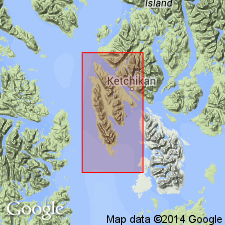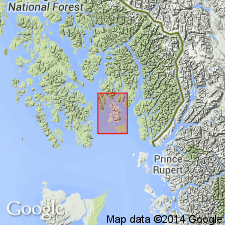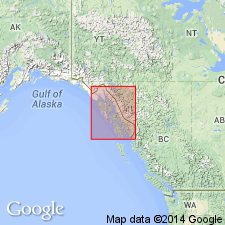
- Usage in publication:
-
- Nehenta Formation*
- Modifications:
-
- Named
- Dominant lithology:
-
- Limestone
- Conglomerate
- Volcanics
- AAPG geologic province:
-
- Alaska Southeastern region
Summary:
Named for marine sedimentary and subordinate volcanic rocks that underlie western Gravina Island from Bostwick Islet to Vallenar Bay, southeastern AK. Type locality: Nehenta Bay-Thompson Cove area, secs.23,25,26, and 36, T77S R90E. Nehenta Formation is divided into three members: 1) calcareous member which crops out nearly continuously from Bostwick Inlet to Vallenar Bay, 2) coarse conglomerate and grit member in Nehenta Bay-Open Bay area and on west coast about four miles north of Nelson Cove, 3) basaltic volcanic member along west coast of Gravina Island for about three miles north of Nelson Cove. Map shows Nehenta Formation unconformably underlies Chapin Formation (Upper Triassic); locally overlies Puppets Formation. Thickness about 1600 ft on Gravina Island, (Buddington and Chapin, 1929). Age is Late Triassic based on HALOBIA (early and middle Norian) from lower part of calcareous member and HETERASTRIDIUM (late Norian) from upper part.
Source: GNU records (USGS DDS-6; Menlo GNULEX).

- Usage in publication:
-
- Nehenta Formation*
- Modifications:
-
- Revised
- AAPG geologic province:
-
- Alaska Southeastern region
Summary:
Nehenta Formation on Gravina island included in Hyd Group which is geographically extended south To Gravina and Annette Islands. Assignment based on similar rock types, stratigraphic position, and age.
Source: GNU records (USGS DDS-6; Menlo GNULEX).

- Usage in publication:
-
- Nehenta Formation*
- Modifications:
-
- Areal extent
- AAPG geologic province:
-
- Alaska Southeastern region
Summary:
Nehenta Formation on Gravina Island included in Hyd Group which is geographically extended south to include rocks on Gravina and Annette Islands. Adopted for the USGS [based on Gehrels, Saleeby, and Berg, 1987]
Source: GNU records (USGS DDS-6; Menlo GNULEX).
For more information, please contact Nancy Stamm, Geologic Names Committee Secretary.
Asterisk (*) indicates published by U.S. Geological Survey authors.
"No current usage" (†) implies that a name has been abandoned or has fallen into disuse. Former usage and, if known, replacement name given in parentheses ( ).
Slash (/) indicates name conflicts with nomenclatural guidelines (CSN, 1933; ACSN, 1961, 1970; NACSN, 1983, 2005, 2021). May be explained within brackets ([ ]).

